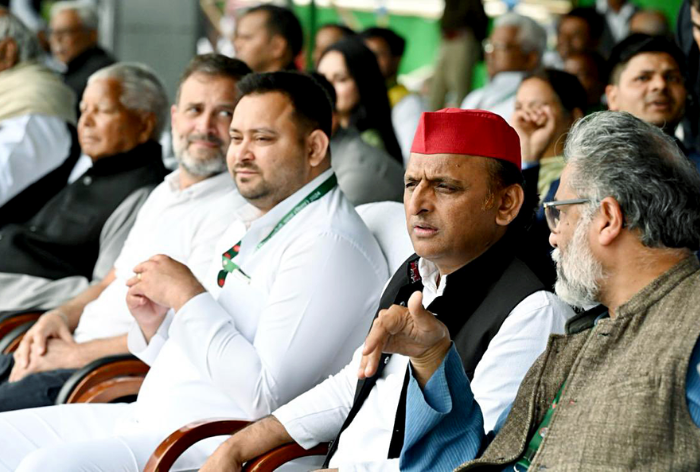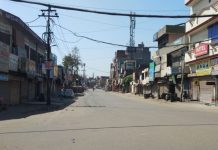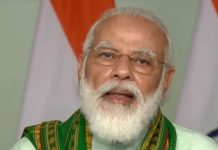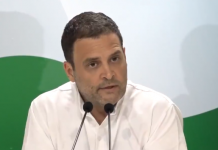A galaxy of opposition leaders including Congress president Kharge, Rahul Gandhi, SP chief Akhilesh and RJD patron Lalu Prasad Yadav came together to showcase the INDIA Bloc’s unity during a mammoth rally held at iconic Gandhi Maidan of Patna. A report by Mudit Mathur

Lok Nayak Jayaprakash Narayan gave a historic call for “Total revolution” from the iconic Gandhi Maidan of Patna on 5th June, 1974, aiming to overthrow the dictatorial rule of Indira Gandhi. Subsequently, in the 1977 general election, the people of India voted her out. The same historic venue was utilized by the INDIA bloc for its Jan Vishwas Rally on March 3, urging the nation to defeat the BJP in the forthcoming Lok Sabha elections with the slogan “Modi Hatao Desh Bachao.” After drawing a record number of crowds at the Patna rally, it will be keenly watched how the united opposition will confront the BJP as the nation gears up for the LS polls.
The Jan Vishwas Rally marked the culmination of extensive public mobilization led by RJD leader Tejashwi Yadav through his confidence-building yatras. This effort resulted in an unprecedented turnout from backward classes, minorities, scheduled castes, and tribals, all rallying around the issue of unemployment. The emergence of apparent battle lines suggests a significant shift towards the “Ram versus Roti” narrative, with a focus on the struggle for social justice among the impoverished and marginalized, who comprise a significant 70 percent of the population.
The challenge before the INDIA bloc leaders is huge, given their internal differences. However, amidst the surging wave of Hindutva following the highly publicized Ram temple consecration ceremony, Prime Minister Narendra Modi’s popularity is purportedly reaching an all-time high, resonating deeply with the majority Hindu community. This stands in stark contrast to 1977 when Indira Gandhi’s popularity had plummeted to its lowest point.
Indira Gandhi rose to the peak of her popularity after she won the 1971 war against Pakistan dividing it into two nations, and creating Bangladesh. But the Iron Lady lost elections in 1977 when she tried to muffle the voice of the entire nation, including the media, snatching fundamental rights and liberties by arbitrarily imposing Emergency throughout India, imprisoning her political opponents, and assuming unbridled powers.
Many new laws were enacted which limited personal freedom. The people of India voted against her to restore democracy against dictatorial tendencies undermining fundamental rights and liberties of the citizens.
The Gandhi Maidan of Patna has been a historical site where, shedding their ideological differences, opposition leaders in 1974 had pledged to oust Indira Gandhi by uniting under the umbrella of the Janata Party. They won the next general election against the mighty Indira Gandhi, the then Prime Minister. However, thereafter, the new government indulged in vendetta politics, as it started harassing Indira Gandhi and even put her behind the bars for her alleged atrocities against opposition leaders.
The Janata Party coalition included right-wing Hindu nationalists, socialists, and former Congress party members. Consequently, there was no ideological glue among them, leading to internal infighting and the eventual downfall of the Janata Party government led by Morarji Desai in August 1979. When fresh elections for the Lok Sabha were held in January, 1980, Indira Gandhi and the Congress (I) swept back to power in a landslide victory.
History is marked by an unmistakable message: the people of India have consistently demonstrated an inherent behavioral trend, standing for freedom, liberty, and democracy to counter the misuse of power by authoritarian figures. Today, history seems to be repeating itself with different characters, as most opposition leaders, including those from the Congress party, have united against Prime Minister Narendra Modi. His government has similarly slapped numerous cases against opponents through central agencies such as the CBI, ED, and Income Tax.
The Election Commission of India is also facing severe allegations of partisanship, as it is perceived to have become a handpicked body of the government. The sudden resignation of Election Commissioner Arun Goel just before the general election reveals uncertainty and stress within the system, especially amid growing opposition to voting through Electronic Voting Machines (EVMs) and demands for the deployment of 100% Voter-Verified Paper Audit Trail (VVPAT). The institution has been under a cloud regarding issues of neutrality, transparency, and accountability.
The successful mobilization of a mammoth turnout at the iconic Gandhi Maidan in Patna has largely been attributed to the organizing skills of Tejashwi Yadav, son of Lalu Prasad Yadav and the leader of the opposition in the Bihar assembly. This comes after Tejashwi Yadav lost the deputy chief ministership due to Chief Minister Nitish Kumar’s U-turn. Nitish Kumar returned to the NDA fold, realigning his ties with the BJP. The inspiring rally assumed political significance at the national level, serving as a collective counter to the BJP’s narrative on the Ram temple, as well as its portrayal as the champion of the Hindu cause and its consistent attacks on ‘dynastic’ parties.
RJD chief Lalu Prasad Yadav took the lead in questioning Narendra Modi’s credentials of being a true follower of Hinduism. He asked why Modi did not shave off his hair when his mother died? Shaving of the head, he said, is part of the rituals defined in “Hindu Shastras” which are to be observed after the death of a parent. His remarks were criticised by BJP followers on social media platforms but Lalu played smart, giving a clear message to his targeted audience assembled in his rally.
Lalu Prasad Yadav drew an emotional connect from the crowds reminding them of Bihar before his times when deep caste inequities were prevalent from the village well to the roads. “We ensured that everyone gets respect,” he said. He also narrated his struggle to implement the Mandal commission report and how backward castes captured power as a result of his efforts. He said because of the commission, all poor, backward castes and Dalits are now standing at the doors of power.
Taking credit for employment of around five lakh youths, Tejashwi compared the brief tenure of the Mahagathbandhan government to 17 years of NDA rule in Bihar. Calling upon people to defeat the BJP in order to save the nation, he said, “I can say with confidence that the BJP is a factory of lies, but the RJD stands for ‘Rights, Jobs and Development’. He mocked Nitish Kumar, who recently ditched him to join the BJP-led NDA, by reciting old Hindi film song – “Idhar chala main udhar chala, Jane kahan main kidhar chala, arey fisal gaya.” “One thing is for sure: Janata Dal United (JDU) will be finished in the 2024 Lok Sabha elections,” Tejashwi thundered.
Addressing the issues of communalism, caste inequalities, unemployment and farmers, Congress leader Rahul Gandhi questioned Prime Minister Narendra Modi about the quantum of farm loans waived so far? “The country has not seen unemployment of this scale in the last 40 years. About 73 per cent OBCs, Dalits and tribals have marginal representation in top positions in private sector, media houses and other places. Among 90 top decision-making bureaucrats, there are only three Dalits,” he revealed. Slamming the Agniveer scheme, Rahul said: “Imagine what kind of soldiers we will prepare with just six months of training and how we can put them up against the better trained troops of Chinese and Pakistani forces.”
Congress president Mallikarjun Kharge severely criticised the NDA. He termed PM Modi as ‘Jhooton ka sardaar‘ (king of lies) even as he urged the public to cast a vote to save democracy and the Constitution.
Prominent political leaders like CPI(M) general secretary Sitaram Yechury, CPI general secretary D Raja, CPI(ML) chief Dipankar Bhattacharya and SP chief Akhilesh Yadav, shared the stage at Patna. Rahul Gandhi, it may be mentioned, left his Bharat Jodo Nyay Yatra to join the rally, highlighting the rally’s significance for the Congress.













